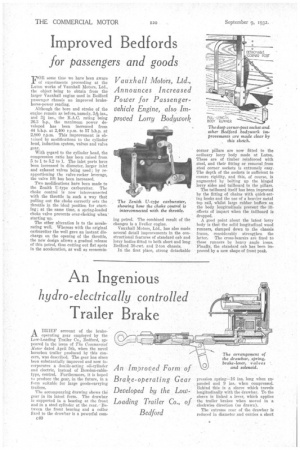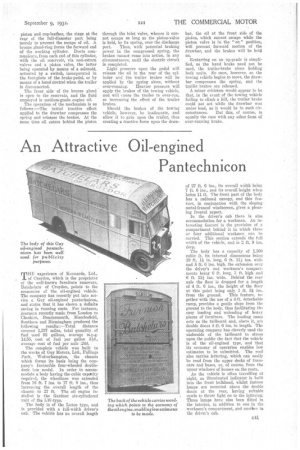An Ingenious
Page 62

Page 63

If you've noticed an error in this article please click here to report it so we can fix it.
hydro-electrically controlled
Trailer Brake
An Improved Form of Brake-operating Gear Developed by the LowLoading Trailer Co., of Bedford
ABRIEF account of the brakeoperating gear employed by the Low-Loading Trailer Co., Bedford, appeared in the issue of The Commercial Motor dated April 5th, when the novel lhorsebox trailer produced by this concern, was described. The gear has since been substantially improved and now incorporates a double-acting oil-cylinder and electric, instead of Bowden-cabletype, control. Furthermore, it is hoped to produce the gear, in the future, in a form suitable for large goods-carrying trailers.
The accompanying drawing shows the gear in its latest form. The drawbar is supported in a bearing at the front and in a steel cylinder at the rear.Between the front bearing and a collar fixed to the drawbar is a powerful corn-. pression spring-16 ins, long when expanded and 9 ins, when compressed. Behind this is a sleeve which travels longitudinally with the drawbar. To the sleeve is linked a lever, which applies the trailer brakes when moved in a clockwise direction (as drawn).
The extreme rear of the drawbar is reduced in diameter and carries a short piston and cup-leather, the rings at the renr of the full-diameter part being merely to prevent the escape of oil. A bronze gland-ring forms the forward end of the working cylinder. Ducts cornmunieate, from each end of this cylinder, with the oil reservoir, via non-return valves and a piston valve, the latter being operated by means of a solenoid, actuated by a switch, incorporated in the foot-plate of the brake-pedal, or by means of a hand control when the trailer is disconnected.
The front side of the bronze gland is open to the reservoir, and the fluid employed is medium-grade engine oil.
The operation of the mechanism is as follows :—The initial tractive effort applied to the drawbar compresses the spring and releases the brakes. At the same time oil enters behind the piston through the inlet valve, whence it cannot escape se long as the piston-valve is held, by its spring, over the discharge port. Thus, with potential braking power in the compressed spring, the brakes cannot come into action, in any circumstances, until the electric circuit is completed.
Light pressure upon the pedal will release the oil in the rear of the cylinder and the trailer brakes will be applied by the spring alone, without over-running, Heavier pressure will apply the brakes of the towing vehicle, and will cause the trailer to over-run, so increasing the effect of the trailer brakes.'
Should the brakes of the towing vehicle, however, be inadequate, and allow it to gain upon the trailer, thus creating a tractive force upon the draw
bar, the oil at the front side of the piston, which cannot escape while the piston valve is in the " on" position, will prevent forward motion of the drawbar, and the brakes will be held on.
Restarting on an up-grade is simplified, as the hand brake need not be used, the trailer-brake alone holding both units. So soon, however, as the towing vehicle begins to move, the drawbar compresses the spring, and the trailer, brakes are released.
A minor criticism would appear to be that, in the event of the towing vehicle failing to climb a hill, the trailer brake could not act while the drawbar was under load, as it would be in such cir cumstances. But this, of course, is equally the case with any other form of over-running brake.












































































































